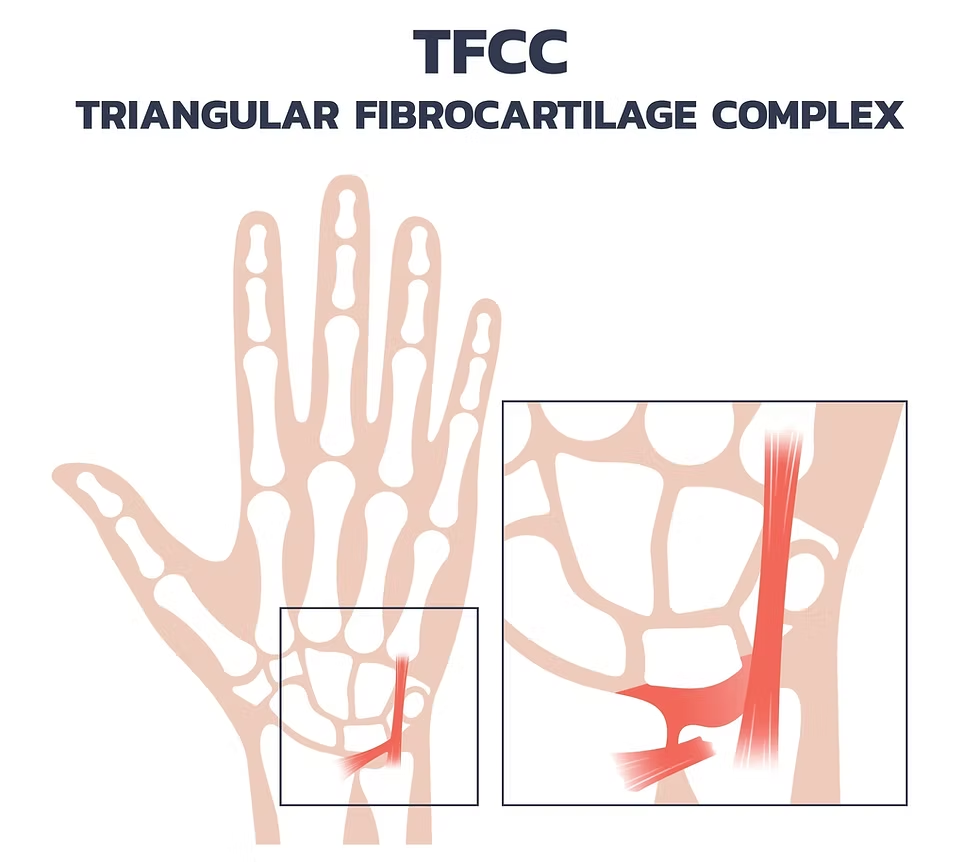Private Hand & Wrist Surgery in Alberta
There are many hand and wrist injuries that may or may not require surgery such as:
- Scaphoid fractures
- Wrist ligament sprains
- DRUJ injuries
- TFCC injuries
- Carpal Tunnel
- Trigger Finger
TFCC injury is very common in the active population. People who use a racquet, bat, club or gymnasts are at higher risk of developing a TFCC tear and people over 50 years old are more likely to experience a degenerative tear.
What is a TFCC tear and what do I do if I think I have one?
The triangular fibrocartilage complex (TFCC) is a soft tissue complex that spans, stabilizes, and tensions the ulnocarpal joint and the distal radioulnar joint (DRUJ). It connects the bones in your forearm (radius and ulna) with bones in your wrist (carpal bones). The complex consists of several ligaments, a meniscal homolog, and an articular disk.9 An articular fibrocartilage disk, which serves to dissipate axial loads.
You can tear your TFCC if you fall on, twist or fracture your wrist. TFCC tears can also result from tissue thinning and wearing down as you age.2 TFCC tears can significantly compromise wrist mobility for patients. The limited vascularity (blood flow) of the TFCC, combined with its intricate soft tissue structure and torsional and axial stresses, makes the TFCC prone to frequent injury while maintaining a limited ability to heal.9
One should not ignore the signs of a TFCC tear as ignoring the injury can lead to worse damage to your wrist and a longer recovery time. A physician can diagnose a TFCC tear through a comprehensive physical exam and diagnostic imaging. This involves a series of hands on tests and diagnostic steps to determine the source of your pain.1
What are the symptoms of a TFCC tear?
You may be experiencing symptoms such as:
- Wrist clicks or pops, when you rotate your wrist or forearm.
- Pain rotating your wrist.
- Pain on the ulnar side of your wrist (outside, near the pinky finger).
- Reduced ability to grip objects tightly.
- Wrist weakness.
In many cases, chronic or degenerative TFCC tears don’t cause pain or other symptoms.2
What are the complications of a TFCC tear?
A minor TFCC tear may heal on its own. But leaving a severe TFCC tear untreated can lead to a weak or unstable wrist.
Complications of a TFCC tear include persistent wrist instability, chronic pain, decreased range of motion, reduced grip strength, further damage to surrounding structures, and potential need for surgery if left untreated, ultimately impairing daily activities due to wrist weakness and instability.
What are the management and treatment options for a TFCC tear?
Minor TFCC tears often heal without treatment. If you don’t have pain or weakness in your wrist, your provider may recommend letting the tear heal on its own through conservative management. For conservative management options, book an appointment with a local Certified Athletic Therapist in your area.2,10
Some TFCC tears cause symptoms and interfere with your ability to perform daily activities. In these cases, your provider may recommend treatment. Options include:2,10
- Medication: Anti-inflammatory medications (such as NSAIDs) can help reduce swelling and relieve pain.
- Bracing: Keeping your forearm and wrist stable with a brace can allow your TFCC to heal.
- Injections: Though less commonly performed, a corticosteroid injection can help reduce the swelling of torn tissue.
- Physical or occupational therapy: Exercises can strengthen the muscles in your wrist and forearm to prevent further injury.
- Surgery: If more conservative treatments don’t provide relief, your provider may recommend surgery. In most cases, minimally invasive surgery can repair TFCC tears.
Operative management is indicated for persistent instability, recalcitrant ulnar-sided wrist pain with concordant physical examination and imaging, acute injuries in high-demand patients, or chronic degenerative tears with ulnar impingement. Over 40% of patients with a TFCC injury may eventually elect for operative management.9
Acumen Health has a Hand & Wrist Specialist, Dr. Tanner Dunlop (Add link to bio), who can assess, review imaging and discuss if surgery is a good option for you.
If you suspect that you have suffered a TFCC tear, book a consultation with an Acumen Health Physician. We provide a comprehensive diagnosis that will determine the extent of the damage. Treatment options will depend on the results of your consultation with one of our experienced physicians. Full recovery depends on receiving the right treatment for your specific needs.
Reference List
- Orthosport and Spine. (n.d.). Wrist Arthroscopy: TFCC Tears. Retrieved February 19, 2025, from https://orthosportandspine.com/wrist-arthroscopy-tfcc-tears
- Cleveland Clinic. (n.d.). Triangular Fibrocartilage Complex Tear (TFCC). Retrieved February 19, 2025, from https://my.clevelandclinic.org/health/diseases/21832-triangular-fibrocartilage-complex-tear-tfcc
- Physio-pedia. (n.d.). Fovea Sign. Retrieved February 19, 2025, from https://www.physio-pedia.com/Fovea_Sign
- Adams, B. D., & Fraser, J. L. (2017). Distal radioulnar joint. In Green’s Operative Hand Surgery (7th ed., pp. 479-513). Elsevier.
- Adams, B. D., & Holley, K. A. (1993). Strains in the articular disk of the triangular fibrocartilage complex: A biomechanical study. Journal of Hand Surgery American Volume, 18(6), 919-925. https://doi.org/10.1016/S0363-5023(05)80274-0
- Palmer, A. K., & Werner, F. W. (1984). Biomechanics of the distal radioulnar joint. Clinical Orthopaedics and Related Research, 1984(184), 26-35.
- Palmer, A. K., Werner, F. W., Glisson, R. R., et al. (1988). Partial excision of the triangular fibrocartilage complex. Journal of Hand Surgery American Volume, 13(4), 391-394. https://doi.org/10.1016/S0363-5023(88)80204-2
- Choudhury, M. M., Ling, A. A., & Yap, R. T. (2024, September 24). Is the ulnar fovea sign positive only in foveal tears of the triangular fibrocartilage complex?. Journal of Hand Surgery (European Volume). https://doi.org/10.1177/17531934241279921
- PubMed Central (PMC). (2020, March 26). Triangular Fibrocartilage Complex Tears and Distal Radioulnar Joint Injuries. Retrieved February 19, 2025, from https://pmc.ncbi.nlm.nih.gov/articles/PMC7543220/
- University of Colorado Anschutz Medical Campus. (n.d.). Triangular Fibrocartilage Complex (TFCC) Tears. Retrieved February 19, 2025, from https://medschool.cuanschutz.edu/orthopedics/andrew-federer-md/practice-expertise/wrist/triangular-fibrocartilage-complex#:~:text=When%20should%20I%20call%20the,Swelling.
- National Center for Biotechnology Information (NCBI). (n.d.). Triangular Fibrocartilage Complex: Overview and Treatment Options. Retrieved February 19, 2025, from https://www.ncbi.nlm.nih.gov/books/NBK537055/#:~:text=Complications%20are%20mostly%20related%20to,a%20limited%20range%20of%20motion.

